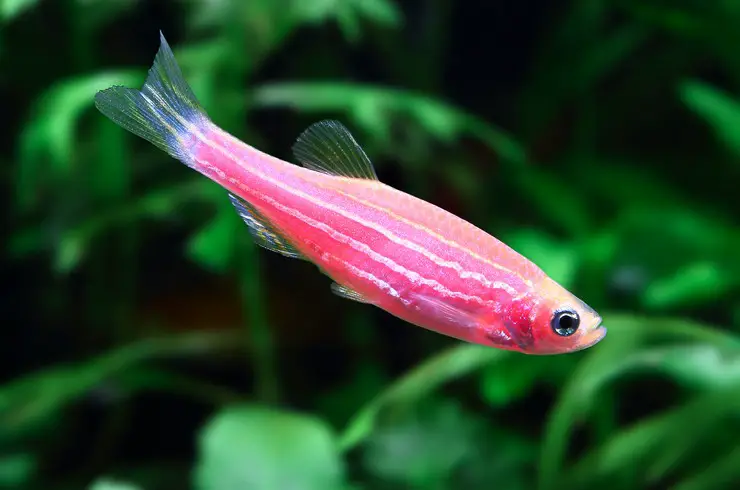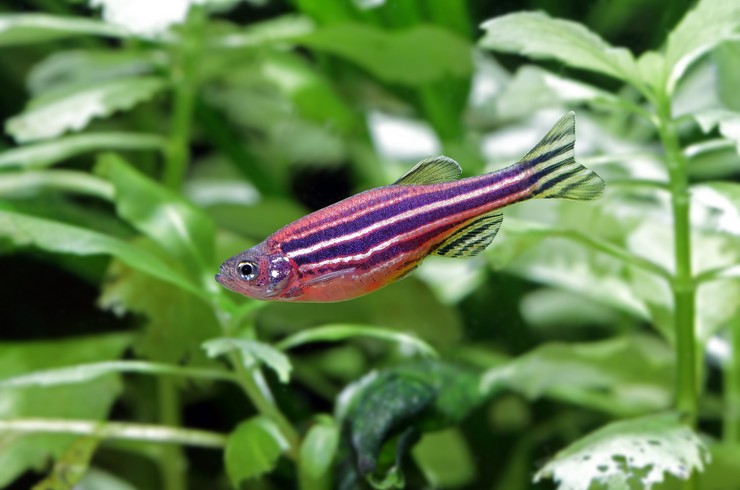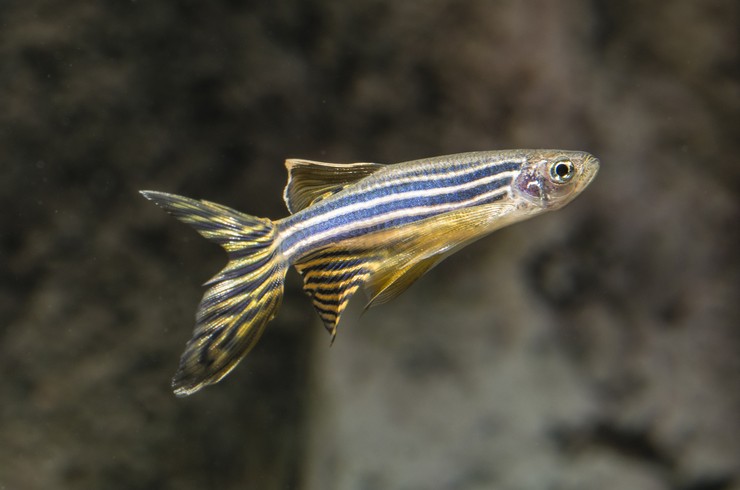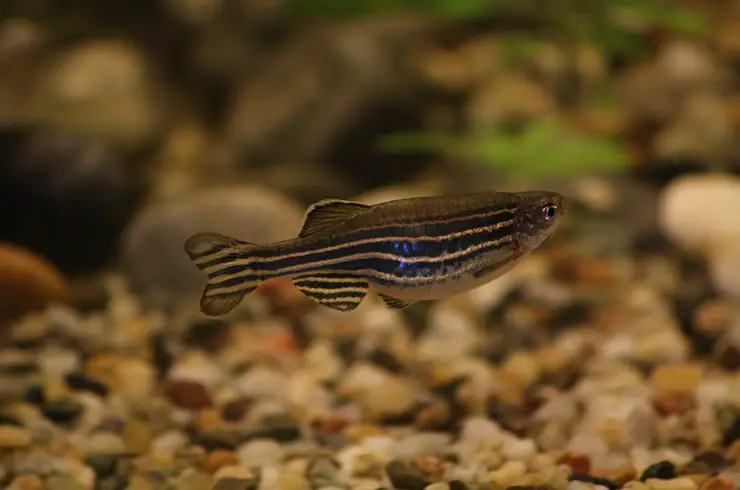In English-speaking countries, this small, unpretentious fish is known as zebrafish – a zebrafish. She received this name for the characteristic alternation of dark and light stripes along the body.
General information
Zebrafish were first introduced as aquarium inhabitants in 1905 and can now be found in aquariums around the world. The key to the popularity of the zebrafish is unpretentiousness in content, attractive bright body color, and a calm character.
The zebrafish is a popular model in biology for studying embryonic development and vertebrate genes. This is due to the fact that the development of eggs occurs very quickly – in just three days, and the embryos themselves are quite large and hardy, which allows you to perform various manipulations with them.
Zebrafish were the first genetically modified fish. The history of the famous GloFish fluorescent fish began with the zebrafish. Just like guppies, zebrafish were honored to fly into space and became one of the objects of study at the orbital station.
Appearance
The size of the zebrafish in the aquarium is 3-6 cm. The body is graceful, elongated. The main body color is pale yellow, the body is covered with wide dark blue stripes, due to which a pattern resembling the color of a zebra is created. The fins are short, almost transparent, and may have a yellow border. Males are distinguished by a slender body; in females, the abdomen is much thicker. On each lip, there is a pair of mustaches, which are usually tightly pressed, therefore invisible.
Besides natural coloration, there are other color variations. Pink zebrafish – differs in the color of the stripes, they are bright pink in the fish.
Leopard zebrafish – has a mottled color that resembles a pattern on the body of a famous predator.
There are also veil varieties with strong fins development.
Habitat
The zebrafish is native to the countries of South Asia. The wide range of this species includes Pakistan, India, Nepal, Bangladesh. This small and agile fish is found in almost any body of water: rivers, streams, canals, ponds, and lakes. The species is characterized by a seasonal change of habitat. During the rainy season, adult zebrafish are ubiquitous in flooded rice paddies and in large puddles. Here they search for food and lay eggs. As soon as the rainy season ends, they prefer to return to large permanent bodies of water.
Care and maintenance
Danio rerio is a very hardy ornamental fish, so they are often turned on by novice aquarists. Indeed, an aquarium of 30 liters will be enough to maintain a minimum flock of zebrafish (5-6 pieces). But the larger the volume, the more comfortable the zebrafish feel. Fish are very mobile, prefer to swim in the upper part of the aquarium. They can jump out of the water, so it is advisable to cover the aquarium with a lid or coverslip.
Danio loves clean water, so care must be taken to ensure proper filtration and adequate aeration. It is advisable to provide good lighting, with suitable lamps the fish will look brighter and more attractive.
Regular water changes are required – 25-30% of the total. Long-stemmed plants are planted along the edges of the aquarium, the rest of the space is left for free swimming for the zebrafish.
Under suitable conditions, zebrafish can live 3-4 years.
Compatibility
Danio rerio is one of the most peaceful fish. It can be hooked up with almost any inhabitants of the aquarium, except for those who will consider it as a food item. Do not combine zebrafish with large cichlids, large goldfish, brocade catfish. It is also not recommended to keep active barbs with zebrafish, especially with veil forms, the long fins of which will necessarily be bitten.
The best neighbors will be proportionate schooling species: neons, minors, tetras. It gets along well with scalars, swordtails, guppies. Even fighting fish – cockerels often do not notice the presence of these eternally scurrying neighbors in the aquarium. Any peaceful catfish (corridors, ancistrus) will also be a good choice for settling in an aquarium with zebrafish because their “food niches” are different: catfish are bottom fish, and zebrafish prefer to swim near the surface of the water.
Feeding
The natural diet of zebrafish is quite varied. They gladly eat small insects and their larvae floating in the water. Do not disdain zebrafish and small seeds falling from plants. In conditions of aquarium keeping, these fish are completely unpretentious in nutrition. They can easily eat live, frozen and dry food. The first two groups of feeds are not able to fully satisfy the nutritional needs of the zebrafish, as they are not balanced and do not contain useful vitamins in the required amount. Therefore, the best choice for feeding zebrafish will be quality dry food.
It should be noted that zebrafish food is preferred to be consumed from the surface. Anything that falls to the bottom usually remains outside their field of interest. Also, the food should be of a suitable size, because the mouth opening of the zebrafish is very small.
Tetra’s wide range of dry foods makes it easy to find the right diet for your zebrafish. These fish prefer to feed on the surface of the water, so it is important that the food stays on the surface for a long time. TetraMin flake food floats very well in the water and then slowly sinks to the bottom. It contains more than 40 types of carefully selected raw materials. It provides a complete diet for the daily nutrition of all ornamental fish species. Supports healthy growth and vitality. The prebiotics included in the composition improves the functioning of the gastrointestinal tract.
Alternatively, you can offer your fish floating foods from the MicroFood series in the form of sticks or pellets. Their size is perfect for small zebrafish mouths. And due to its high buoyancy, food remains in the upper layers of water for a long time.
Due to the high digestibility of feed, fish produce less waste, which allows the water to remain clean for a long time.
It is necessary to feed the fish several times a day with such a portion of food that they will eat in a few minutes.
Reproduction and breeding
Puberty in zebrafish occurs at 3-6 months. Fish are capable of spawning at any time of the year. First, you need to choose a pair. You can determine the gender by the shape of the body: in females, the abdomen is more convex than in males.
Producers need to be planted in separate aquariums from 10 liters and fed abundantly with high-protein food – bloodworms or daphnia for several days. The readiness of the female for spawning is not difficult to determine: the abdomen becomes convex not only in the front part of the body but also at the anal fin.
Any container with a volume of 30 liters or more is suitable as a spawning aquarium, it is better not to put the soil in it, it is more convenient to observe the throwing of eggs and their development. It is best to place a grate on the bottom to prevent producers from reaching the eggs. It will be useful to place plants with small leaves in the spawning grounds.
The aquarium must be installed on a windowsill or near a window, then it is filled with water so that its level is 6-10 cm. The temperature in the jig does not play a serious role, but it should not be very low. Breeders (usually 2-3 males and one female) are planted in the spawning grounds in the late afternoon.
After sunrise, spawning begins. The fishes move rapidly around the aquarium, the males chase the female, hit her in the abdomen to knock out eggs, and then release milk on her. The frequency of the whiskers is about 5 minutes, the entire spawning usually ends within an hour.
During one spawning, the female is able to sweep away up to 400 eggs. The amount depends on the age, size of the female, preparedness for spawning.
If a situation is observed in the aquarium when the female does not react to the males in any way and tries to hide, then the eggs are probably not yet ripe. In this case, it is better to plant the female again for several days and wait until the eggs are fully ripe. If the males do not show any attention to the female, they should also be placed in a separate container, increase the temperature and feed them vigorously. When the males start chasing each other, it’s time to bring them to the female ready to spawn.
At a temperature of 26-28 ° C, the caviar ripens within 30-36 hours, at a lower temperature, the process can take a week.

